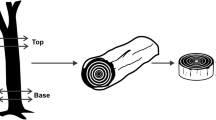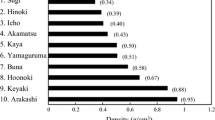Abstract
Grain deviations and high extractives content are common features of many tropical woods. This study aimed at clarifying their respective impact on vibrational properties, referring to African Padauk (Pterocarpus soyauxii Taub.), a species selected for its interlocked grain, high extractives content and uses in xylophones. Specimens were cut parallel to the trunk axis (L), and local variations in grain angle (GA), microfibril angle (MFA), specific Young’s modulus (E′ L /ρ, where ρ stands for the density) and damping coefficient (tanδL) were measured. GA dependence was analysed by a mechanical model which allowed to identify the specific Young’s modulus (E′3/ρ) and shear modulus (G′/ρ) along the grain (3) as well as their corresponding damping coefficients (tanδ3, tanδG). This analysis was done for native and then for extracted wood. Interlocked grain resulted in 0–25° GA and in variations of a factor 2 in E′L/ρ and tanδL. Along the grain, Padauk wood was characterized, when compared to typical hardwoods, by a somewhat lower E′3/ρ and elastic anisotropy (E′/G′), due to a wide microfibril angle plus a small weight effect of extracts, and a very low tanδ3 and moderate damping anisotropy (tanδG/tanδ3). Extraction affected mechanical parameters in the order: tanδ3 ≈ tanδG > G′/ρ > > E′3/ρ. That is, extractives’ effects were nearly isotropic on damping but clearly anisotropic on storage moduli.






Similar content being viewed by others
References
Akitsu H, Gril J, Norimoto M (1993) Uniaxial modelling of vibrational properties of chemically modified wood. Mokuzai Gakkaishi 39:258–264
Aramaki M, Baillères H, Brancheriau L, Kronland-Martinet R, Ystad S (2007) Sound quality assessment of wood for xylophone bars. J Acoust Soc Am 121:2407–2421
Bodig J, Jayne BA (1982) Mechanics of wood and wood composites: Van Nostrand Reinhold, New York
Brémaud I (2006) Diversity of woods used or usable in musical instruments making. Experimental study of vibrational properties in axial direction of contrasted wood types mainly tropical. Relationships to features of microstructure and secondary chemical composition. (in French). PhD in mechanics of materials, University of Montpellier II
Brémaud I, Amusant N, Minato K, Gril J, Thibaut B (2010a) Effect of extractives on vibrational properties of African Padauk (Pterocarpus soyauxii Taub.). Wood Sci Technol. doi 10.1007/s00226-010-0337-3
Brémaud I, Gril J, Thibaut B (2010b) Anisotropy of wood vibrational properties: dependence on grain angle and review of literature data. Submitted to Wood Sci Technol
Caldersmith G, Freeman E (1990) Wood properties from sample plate measurements I. J Catgut Acoust Soc 1(series II):8–12
Cave ID (1966) Theory of X-ray measurement of microfibril angle in wood. For Prod J 16:37–42
Gachet C, Guitard D (2006) Influence relative de la morphologie cellulaire et de l′angle des microfibrilles sur l′anisotropie élastique tissulaire Longitudinale/Tangentielle du bois sans défaut des résineux. Ann For Sci 63:275–283
Guitard D, El Amri F (1987) Modèles prévisionnels de comportement élastique tridimensionnel pour les bois feuillus et les bois résineux. Ann Sci For 44:335–348
Harris JM (1989) Spiral grain and wave phenomena in wood formation. Springer, Berlin
Hase N (1987) A comparison between acoustic physical factors of Honduras rosewood for marimbas and xylophones and a sensory evaluation of these instruments. Mokuzai Gakkaishi 33:762–768
Hillis WE, Evans R, Washusen R (2004) An unusual formation of tension wood in a natural forest Acacia sp. Holzforschung 58:241–245
Matsunaga M, Minato K, Nakatsubo F (1999) Vibrational property changes of spruce wood by impregnation with water-soluble extractives of pernambuco (Guilandina echinata Spreng.). J Wood Sci 45:470–474
Minato K, Sakai K, Matsunaga M, Nakatsubo F (1997) The vibrational properties of wood impregnated with extractives of some species of Leguminosae. Mokuzai Gakkaishi 43:1035–1037
Minato K, Konaka Y, Brémaud I, Suzuki S, Obataya E (2010) Extractives of muirapiranga (Brosimun sp.) and its effects on the vibrational properties of wood. J Wood Sci 56:41–46
Norimoto M, Tanaka F, Ohogama T, Ikimune R (1986) Specific dynamic young’s modulus and internal friction of wood in the longitudinal direction (in Japanese). Wood Res Tech Notes 22:53–65
Obataya E, Umezawa T, Nakatsubo F, Norimoto M (1999) The effects of water-soluble extractives on the acoustic properties of reed (Arundo donax L.). Holzforschung 53:63–67
Obataya E, Ono T, Norimoto M (2000) Vibrational properties of wood along the grain. J Mater Sci 35:2993–3001
Ogata Y, Fujita M, Nobuchi T, Sahri MH (2003) Macroscopic and anatomical investigation of interlocked grain in Acacia mangium. IAWA J 24:13–26
Ono T, Kataoka A (1979) The frequency dependance of the dynamic Young’s modulus and internal friction of wood used for the soundboard of musical Instruments II. The dependance of the Young’s modulus and internal friction on frequency, and the mechanical frequency dispersion (in Japanese). Mokuzai Gakkaishi 25:535–542
Ono T, Norimoto M (1983) Study on Young’s modulus and internal friction of wood in relation to the evaluation of wood for musical instruments. Jpn J Appl Phys 22:611–614
Rasband WS (1997–2008) Image J. U. S. National Institutes of Health, Bethesda, Maryland, USA.http://rsb.info.nih.gov/ij/
Sakai K, Masahiro M, Minato K, Nakatsubo F (1999) Effects of impregnation of simple phenolics and natural polycyclic compounds on physical properties of wood. J Wood Sci 45:227–232
Sarén M-P, Serimaa R (2006) Determination of microfibril angle distribution by X-ray diffraction. Wood Sci Technol 40:445–460
Sarén M-P, Serimaa R, Tolonen Y (2006) Determination of fibre orientation in Norway spruce using X-ray diffraction and laser scattering. Holz Roh Werkst 64:183–188
Schulgasser K, Witztum A (2007) The mechanism of spiral grain formation in trees. Wood Sci Technol 41:133–156
Yano H (1994) The changes in the acoustic properties of Western Red Cedar due to methanol extraction. Holzforschung 48:491–495
Yano H, Kyou K, Furuta Y, Kajita H (1995) Acoustic properties of Brazilian rosewood used for guitar back plate. Mokuzai Gakkaishi 41:17–24
Acknowledgments
We are grateful to Yves ElKaïm, in LMGC, for setting up the interface for vibrational tests, and to Arie Van Der Lee (IEM Montpellier) for his help in XRD measurements. This work has been supported by a Fellowship from Japanese Society for the Promotion of Science.
Author information
Authors and Affiliations
Corresponding author
Additional information
This article is dedicated to Gerd Wegener on the occasion of his retirement as professor at the Technische Universität München.
An erratum to this article can be found at http://dx.doi.org/10.1007/s00226-010-0369-8
Rights and permissions
About this article
Cite this article
Brémaud, I., Cabrolier, P., Gril, J. et al. Identification of anisotropic vibrational properties of Padauk wood with interlocked grain. Wood Sci Technol 44, 355–367 (2010). https://doi.org/10.1007/s00226-010-0348-0
Received:
Published:
Issue Date:
DOI: https://doi.org/10.1007/s00226-010-0348-0




